Characteristics and Applications of Spatiotemporally Focused Femtosecond Laser Pulses
Abstract
:1. Introduction
2. The Basic Principles of the SSTF Technique and Characteristics of SSTF Pulses
3. Applications of the SSTF Technique in Femtosecond Laser Micromachining
4. Applications of SSTF Technique in Femtosecond Laser Filamentation
5. Applications of SSTF Technique in Manipulation of Plasma Dynamics
6. Summary and Outlook
Acknowledgments
Author Contributions
Conflicts of Interest
Appendix
References
- Beresna, M.; Gecevičius, M.; Kazansky, P.G. Ultrafast laser direct writing and nanostructuring in transparent materials. Adv. Opt. Photonics 2014, 6, 293–339. [Google Scholar] [CrossRef]
- Sugioka, K.; Cheng, Y. Femtosecond laser three-dimensional micro- and nanofabrication. Appl. Phys. Rev. 2014, 1. [Google Scholar] [CrossRef]
- Osellame, R.; Hoekstra, H.J.W.M.; Cerullo, G.; Pollnau, M. Femtosecond laser microstructuring: An enabling tool for optofluidic lab-on-chips. Laser Photonics Rev. 2011, 5, 442–463. [Google Scholar] [CrossRef]
- Ams, M.; Marshall, G.D.; Dekker, P.; Piper, J.A.; Withford, M.J. Ultrafast laser written active devices. Laser Photonics Rev. 2009, 3, 535–544. [Google Scholar] [CrossRef]
- Kawata, S.; Sun, H.B.; Tanaka, T.; Takada, K. Finer features for functional microdevices. Nature 2001, 412, 697–698. [Google Scholar] [CrossRef] [PubMed]
- Liao, Y.; Cheng, Y.; Liu, C.; Song, J.; He, F.; Shen, Y.; Chen, D.; Xu, Z.; Fan, Z.; Wei, X.; et al. Direct laser writing of sub-50 nm nanofluidic channels buried in glass for three-dimensional micro-nanofluidic integration. Lab Chip 2013, 13, 1626–1631. [Google Scholar] [CrossRef] [PubMed]
- Sugioka, K.; Cheng, Y. Ultrafast lasers—Reliable tools for advanced materials processing. Light Sci. Appl. 2014, 3. [Google Scholar] [CrossRef]
- Osellame, R.; Taccheo, S.; Marangoni, M.; Ramponi, R.; Laporta, P.; Polli, D.; De Silvestri, S.; Cerullo, G. Femtosecond writing of active optical waveguides with astigmatically shaped beams. J. Opt. Soc. Am. B 2003, 20, 1559–1567. [Google Scholar] [CrossRef]
- Cheng, Y.; Sugioka, K.; Midorikawa, K.; Masuda, M.; Toyoda, K.; Kawachi, M.; Shihoyama, K. Control of the cross-sectional shape of a hollow microchannel embedded in photostructurable glass by use of a femtosecond laser. Opt. Lett. 2003, 28, 55–57. [Google Scholar] [CrossRef] [PubMed]
- Sugioka, K.; Cheng, Y.; Midorikawa, K.; Takase, F.; Takai, H. Femtosecond laser microprocessing with three-dimensionally isotropic spatial resolution using crossed-beam irradiation. Opt. Lett. 2006, 31, 208–210. [Google Scholar] [CrossRef] [PubMed]
- Oron, D.; Tal, E.; Silberberg, Y. Scanningless depth-resolved microscopy. Opt. Express 2005, 13, 1468–1476. [Google Scholar] [CrossRef] [PubMed]
- Zhu, G.; van Howe, J.; Durst, M.; Zipfel, W.; Xu, C. Simultaneous spatial and temporal focusing of femtosecond pulses. Opt. Express 2005, 13, 2153–2159. [Google Scholar] [CrossRef] [PubMed]
- Block, E.; Greco, M.; Vitek, D.; Masihzadeh, O.; Ammar, D.A.; Kahook, M.Y.; Mandava, N.; Durfee, C.; Squier, J. Simultaneous spatial and temporal focusing for tissue ablation. Biomed. Opt. Express 2013, 4, 831–841. [Google Scholar] [CrossRef] [PubMed]
- Kammel, R.; Ackermann, R.; Thomas, J.; Götte, J.; Skupin, S.; Tünnermann, A.; Nolte, S. Enhancing precision in fs-laser material processing by simultaneous spatial and temporal focusing. Light Sci. Appl. 2014, 3. [Google Scholar] [CrossRef]
- Lanier, T.E.; Gulley, J.R. Nonlinear space-time focusing and filamentation of annular femtosecond pulses in dielectrics. J. Opt. Soc. Am. B 2016, 33, 292–301. [Google Scholar] [CrossRef]
- Li, Y.-C.; Cheng, L.-C.; Chang, C.-Y.; Lien, C.-H.; Campagnola, P.J.; Chen, S.-J. Fast multiphoton microfabrication of freeform polymer microstructures by spatiotemporal focusing and patterned excitation. Opt. Express 2012, 20, 19030–19038. [Google Scholar] [CrossRef] [PubMed]
- Kim, D.; So, P.T. High-throughput three-dimensional lithographic microfabrication. Opt. Lett. 2010, 35, 1602–1604. [Google Scholar] [CrossRef] [PubMed]
- He, F.; Xu, H.; Cheng, Y.; Ni, J.; Xiong, H.; Xu, Z.; Sugioka, K.; Midorikawa, K. Fabrication of microfluidic channels with a circular cross section using spatiotemporally focused femtosecond laser pulses. Opt. Lett. 2010, 35, 1106–1108. [Google Scholar] [CrossRef] [PubMed]
- He, F.; Cheng, Y.; Lin, J.; Ni, J.; Xu, Z.; Sugioka, K.; Midorikawa, K. Independent control of aspect ratios in the axial and lateral cross sections of a focal spot for three-dimensional femtosecond laser micromachining. New J. Phys. 2011, 13. [Google Scholar] [CrossRef]
- Durfee, C.G.; Squier, J.A. Breakthroughs in photonics 2014: Spatiotemporal focusing: Advances and applications. IEEE Photonics J. 2015, 7, 0700806. [Google Scholar] [CrossRef]
- Zeng, B.; Chu, W.; Gao, H.; Liu, W.; Li, G.; Zhang, H.; Yao, J.; Ni, J.; Chin, S.L.; Cheng, Y.; Xu, Z. Enhancement of peak intensity in a filament core with spatiotemporally focused femtosecond laser pulses. Phys. Rev. A 2011, 84. [Google Scholar] [CrossRef]
- Couairona, A.; Mysyrowicz, A. Femtosecond filamentation in transparent media. Phys. Rep. 2007, 441, 47–189. [Google Scholar] [CrossRef]
- Vitek, D.N.; Block, E.; Bellouard, Y.; Adams, D.E.; Backus, S.; Kleinfeld, D.; Durfee, C.G.; Squier, J.A. Spatio-temporally focused femtosecond laser pulses for nonreciprocal writing in optically transparent materials. Opt. Express. 2010, 18, 24673–24678. [Google Scholar] [CrossRef] [PubMed]
- He, F.; Zeng, B.; Chu, W.; Ni, J.; Sugioka, K.; Cheng, Y.; Durfee, C.G. Characterization and control of peak intensity distribution at the focus of a spatiotemporally focused femtosecond laser beam. Opt. Express 2014, 22, 9734–9748. [Google Scholar] [CrossRef] [PubMed]
- Li, G.; Ni, J.; Xie, H.; Zeng, B.; Yao, J.; Chu, W.; Zhang, H.; Jing, C.; He, F.; Xu, H.; Cheng, Y.; Xu, Z. Second harmonic generation in centrosymmetric gas with spatiotemporally focused intense femtosecond laser pulses. Opt. Lett. 2014, 39, 961–964. [Google Scholar] [CrossRef] [PubMed]
- Wang, Z.; Zeng, B.; Li, G.; Xie, H.; Chu, W.; He, F.; Liao, Y.; Liu, W.; Gao, H.; Cheng, Y. Time-resolved shadowgraphs of transient plasma induced by spatiotemporally focused femtosecond laser pulses in fused silica glass. Opt. Lett. 2015, 40, 5726–5729. [Google Scholar] [CrossRef] [PubMed]
- He, F.; Wang, Z.; Zeng, B.; Ni, J.; Cheng, Y.; Sugioka, K. Extraordinary characteristics of spatiotemporally focused laser pulses and their roles in precision materials processing. CLEO 2015. [Google Scholar] [CrossRef]
- Zhang, S.; Asoubar, D.; Kammel, R.; Nolte, S.; Wyrowski, F. Analysis of pulse front tilt in simultaneous spatial and temporal focusing. J. Opt. Soc. Am. A 2014, 31, 2437–2446. [Google Scholar] [CrossRef] [PubMed]
- Coughlan, M.A.; Plewicki, M.; Levis, R.J. Parametric spatio-temporal control of focusing laser pulses. Opt. Express 2009, 17, 15808–15820. [Google Scholar] [CrossRef] [PubMed]
- Wang, Z.; He, F.; Ni, J.; Jing, C.; Xie, H.; Zeng, B.; Chu, W.; Qiao, L.; Cheng, Y. Interferometric characterization of pulse front tilt of spatiotemporally focused femtosecond laser pulses. Opt. Express 2014, 22, 26328–26337. [Google Scholar] [CrossRef] [PubMed]
- Tan, Y.; Wang, Z.; Chu, W.; Liao, Y.; Qiao, L.; Cheng, Y. High-throughput in-volume processing in glass with isotropic spatial resolutions in three dimensions. Opt. Mater. Express 2016, 6, 3787–3793. [Google Scholar] [CrossRef]
- Vitek, D.N.; Adams, D.E.; Johnson, A.; Tsai, P.S.; Backus, S.; Durfee, C.G.; Kleinfeld, D.; Squier, J.A. Temporally focused femtosecond laser pulses for low numerical aperture micromachining through optically transparent materials. Opt. Express 2010, 18, 18086–18094. [Google Scholar] [CrossRef] [PubMed]
- Kazansky, P.G.; Yang, W.; Bricchi, E.; Bovatsek, J.; Arai, A.; Shimotsuma, Y.; Miura, K.; Hirao, K. “Quill” writing with ultrashort light pulses in transparent materials. Appl. Phys. Lett. 2007, 90. [Google Scholar] [CrossRef]
- Salter, P.S.; Booth, M.J. Dynamic control of directional asymmetry observed in ultrafast laser direct writing. Appl. Phys. Lett. 2012, 101. [Google Scholar] [CrossRef]
- Chin, S.L. Femtosecond Laser Filamentation; Springer: New York, NY, USA, 2010. [Google Scholar]
- Théberge, F.; Liu, W.; Simard, P.; Becker, A.; Chin, S.L. Plasma density inside a femtosecond laser filament in air: Strong dependence on external focusing. Phys. Rev. E 2006, 74. [Google Scholar] [CrossRef] [PubMed]
- Zeng, B.; Wang, T.; Hosseini, S.; Cheng, Y.; Xu, Z.; Liu, W.; Chin, S.L. Enhanced remote filament-induced breakdown spectroscopy with spatio-temporally chirped pulses. J. Opt. Soc. Am. B 2012, 29, 3226–3230. [Google Scholar] [CrossRef]

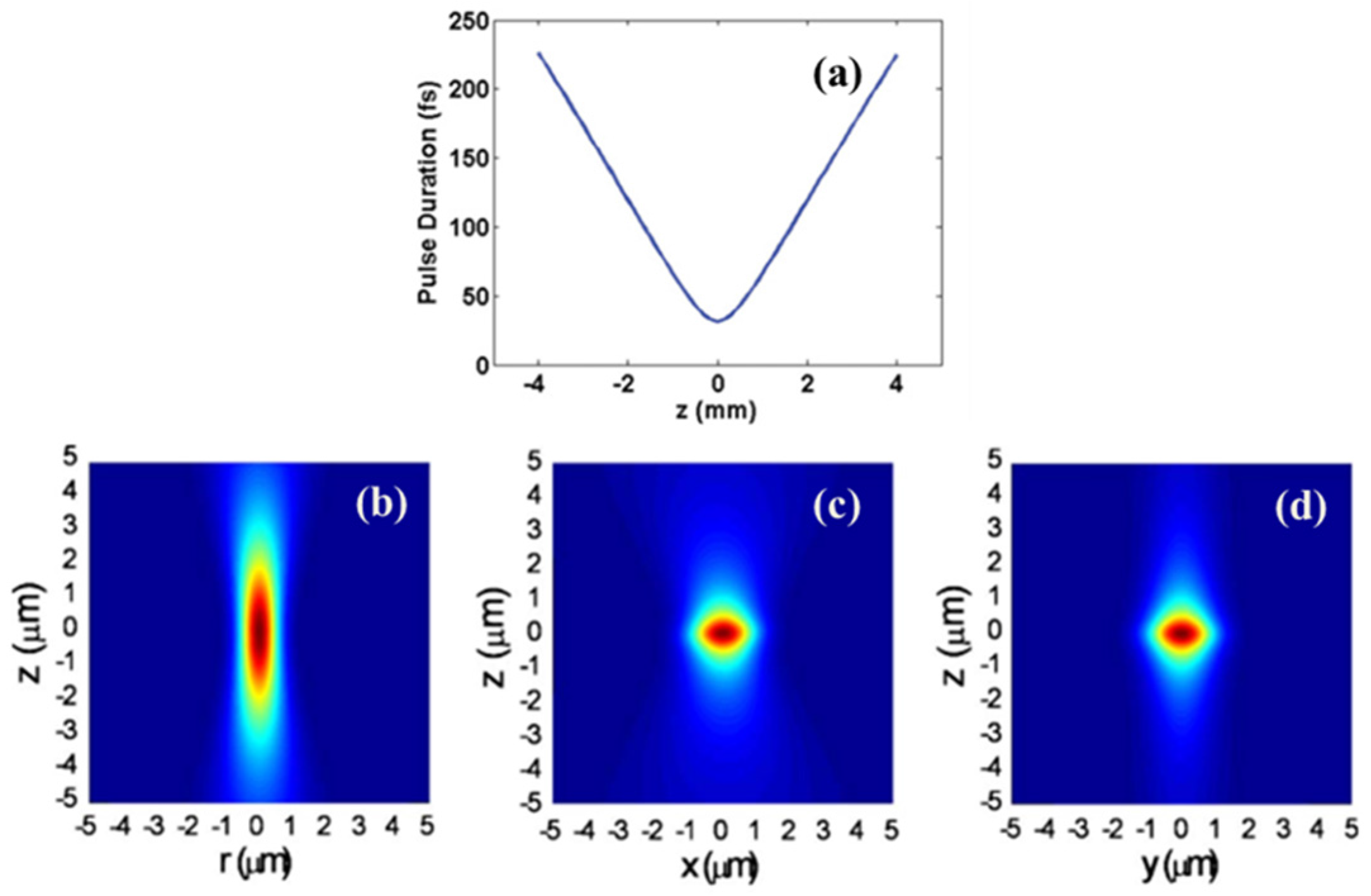
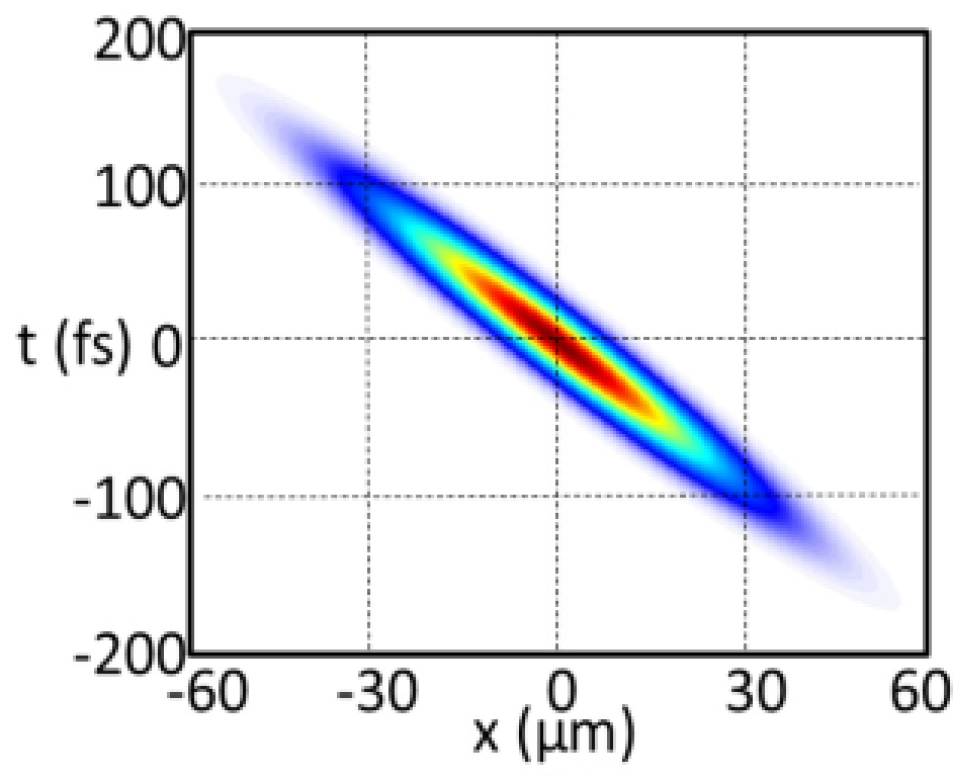

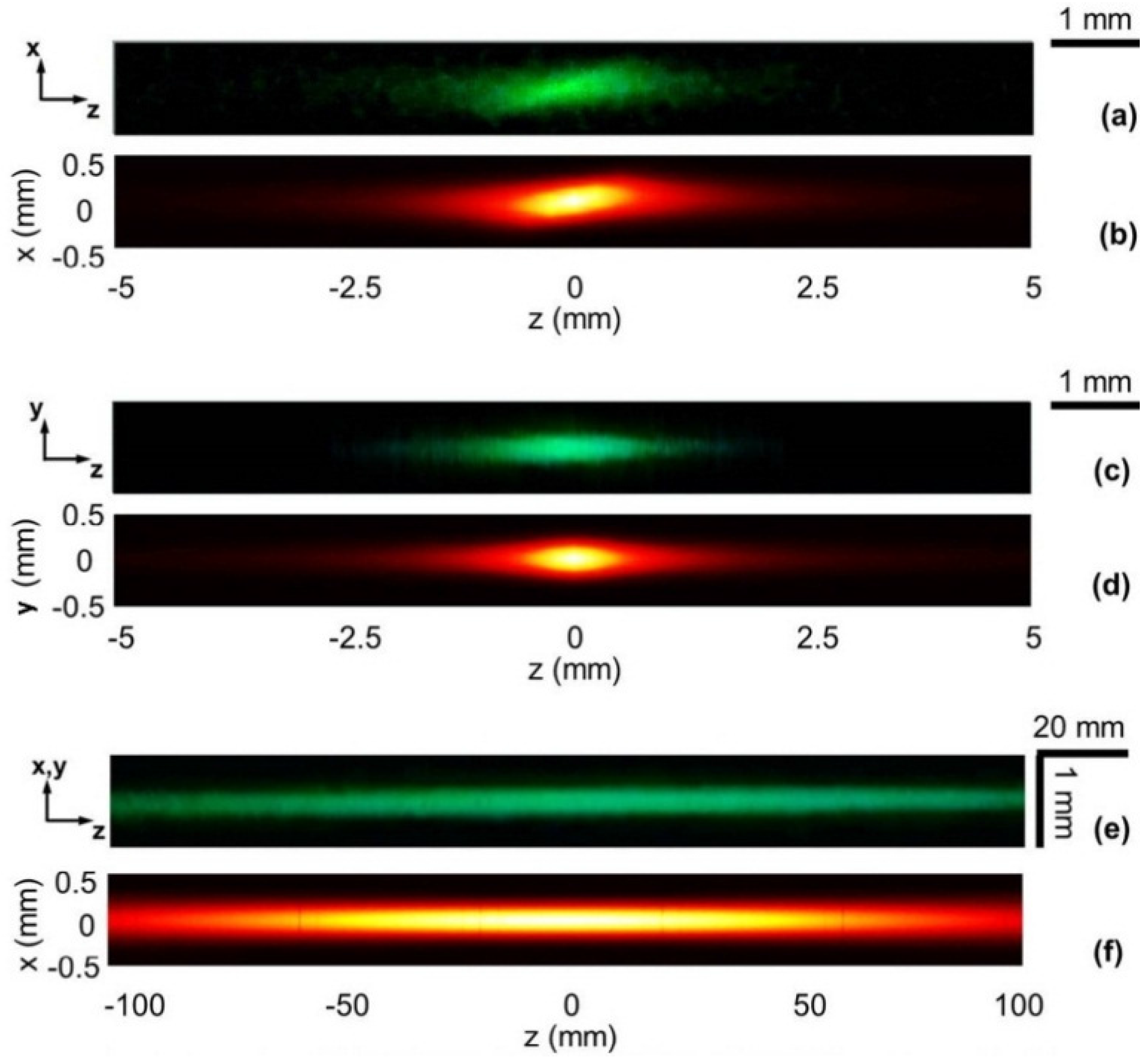
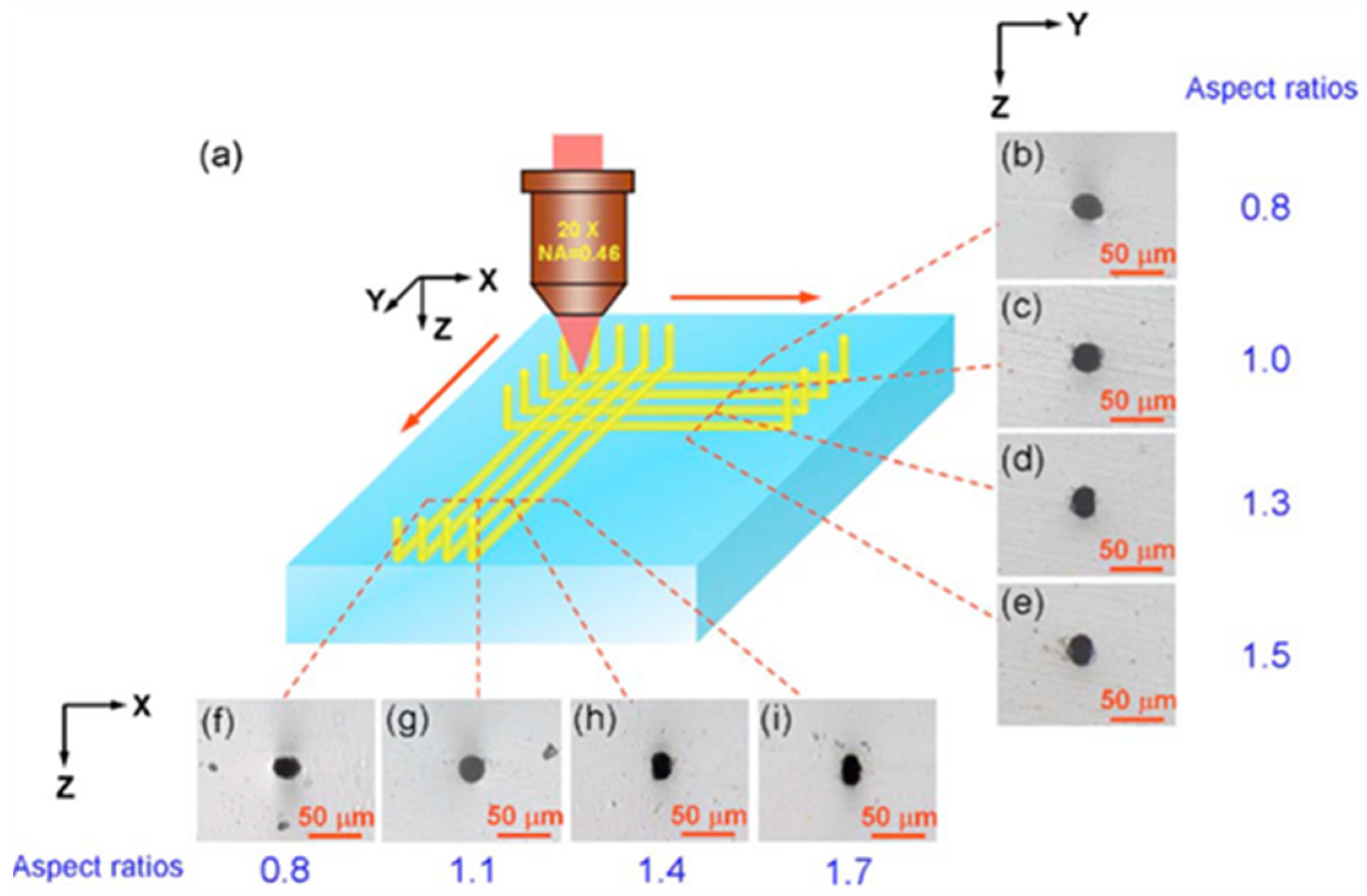
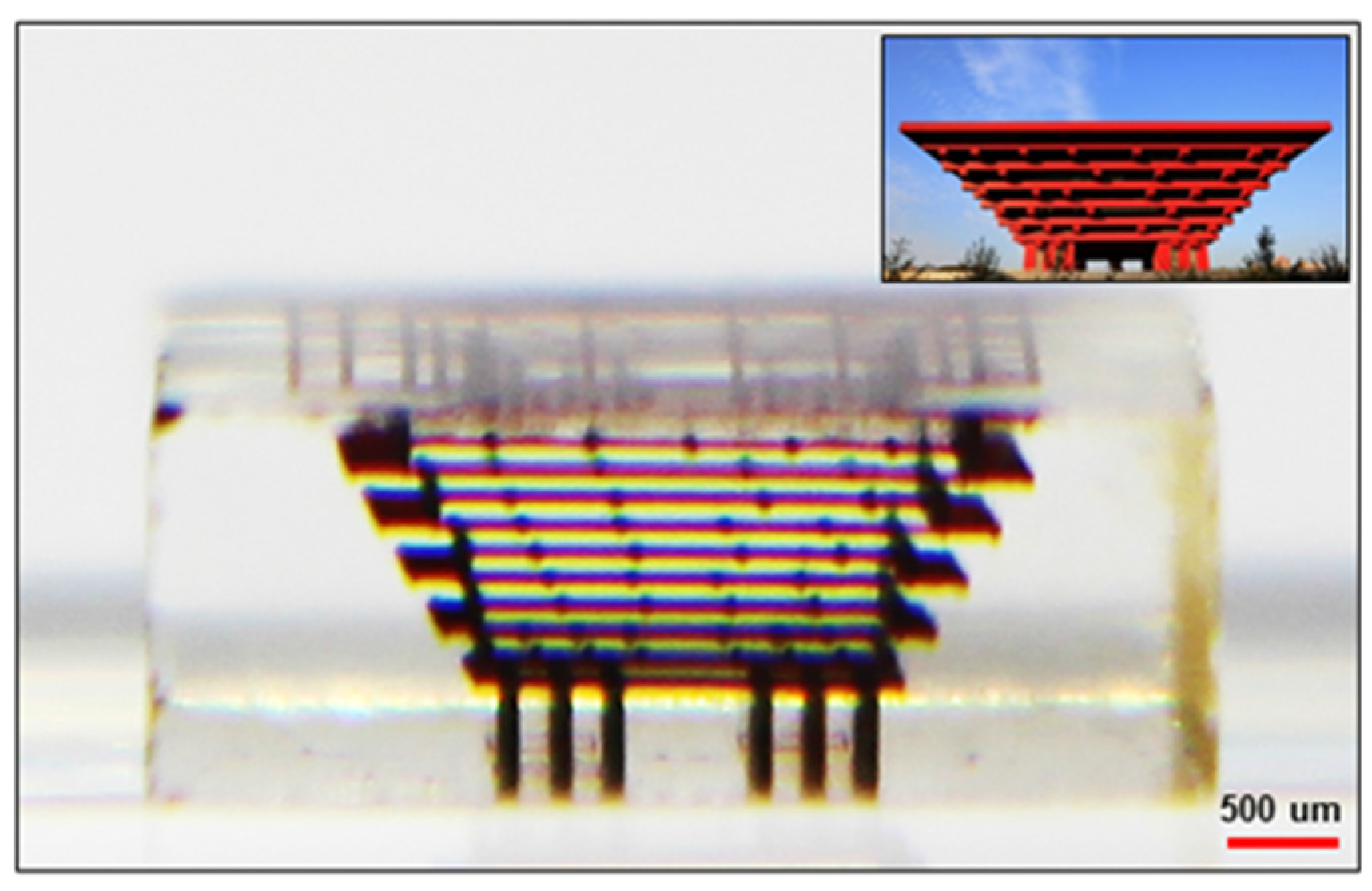
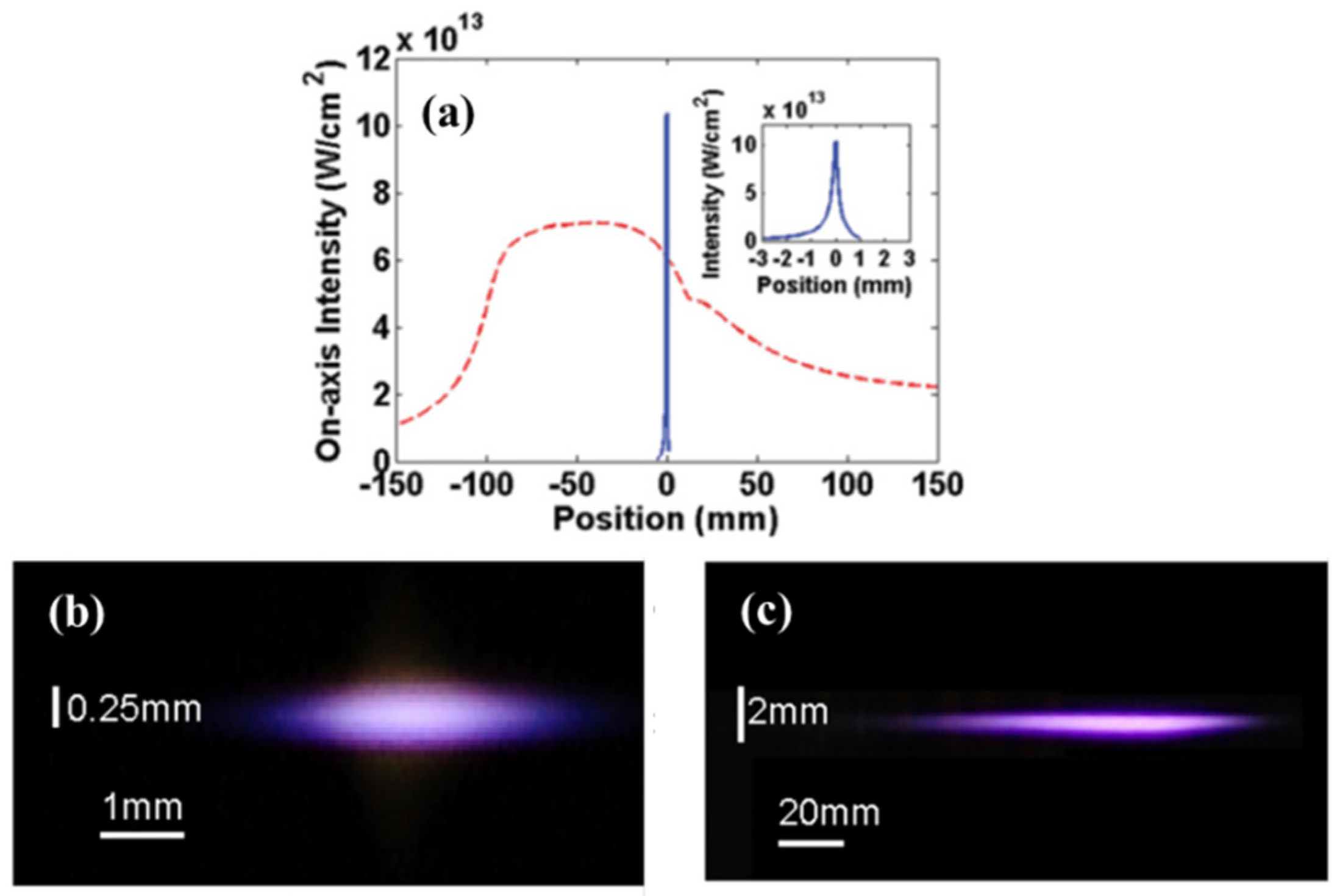
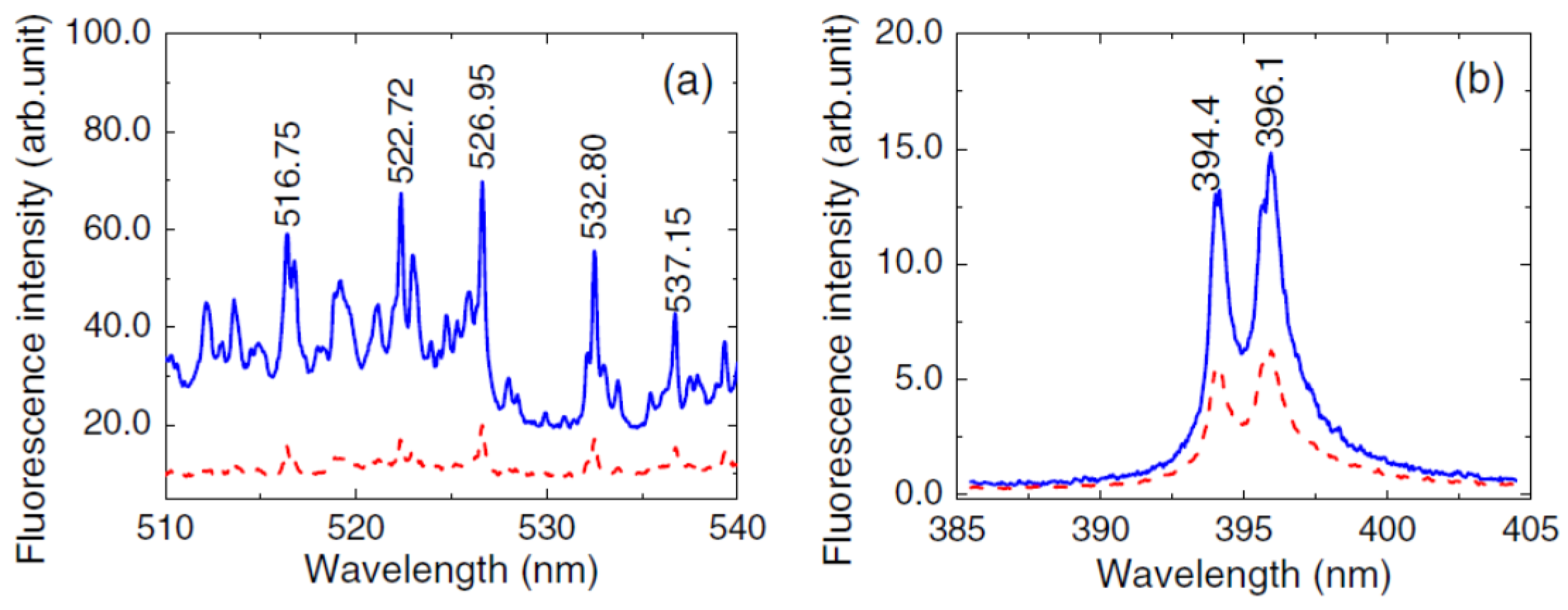
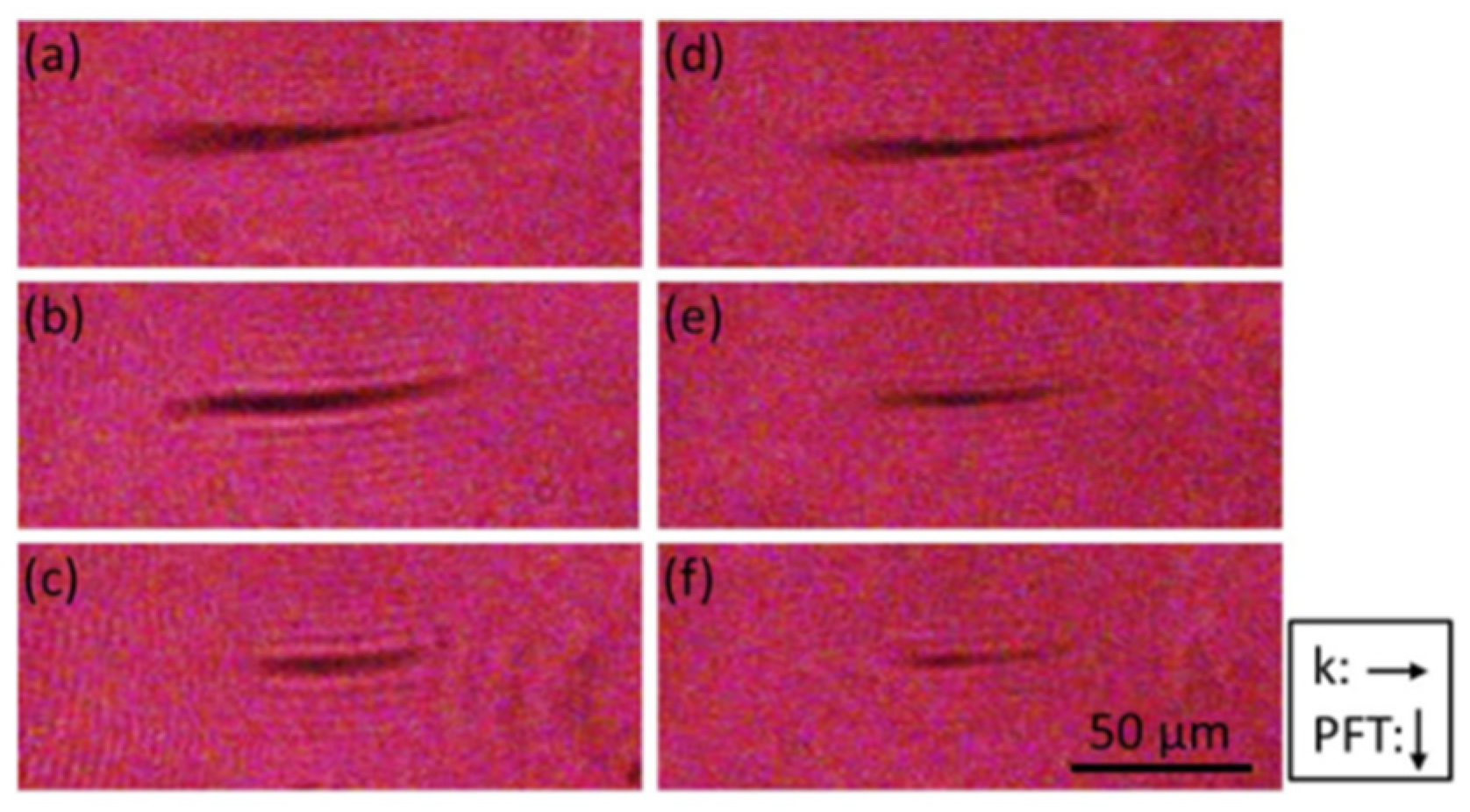
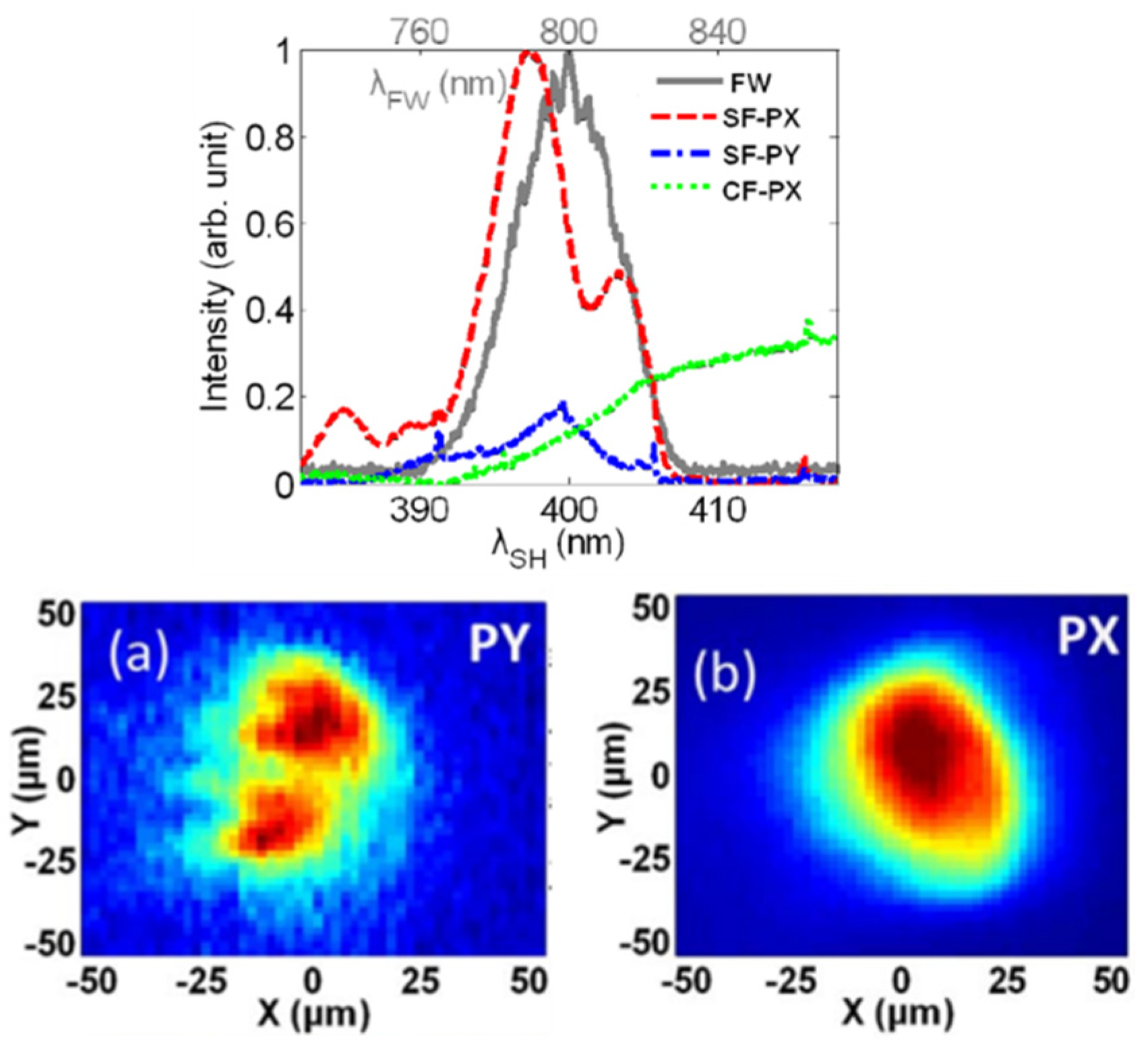
© 2016 by the authors; licensee MDPI, Basel, Switzerland. This article is an open access article distributed under the terms and conditions of the Creative Commons Attribution (CC-BY) license (http://creativecommons.org/licenses/by/4.0/).
Share and Cite
Jing, C.; Wang, Z.; Cheng, Y. Characteristics and Applications of Spatiotemporally Focused Femtosecond Laser Pulses. Appl. Sci. 2016, 6, 428. https://doi.org/10.3390/app6120428
Jing C, Wang Z, Cheng Y. Characteristics and Applications of Spatiotemporally Focused Femtosecond Laser Pulses. Applied Sciences. 2016; 6(12):428. https://doi.org/10.3390/app6120428
Chicago/Turabian StyleJing, Chenrui, Zhaohui Wang, and Ya Cheng. 2016. "Characteristics and Applications of Spatiotemporally Focused Femtosecond Laser Pulses" Applied Sciences 6, no. 12: 428. https://doi.org/10.3390/app6120428





